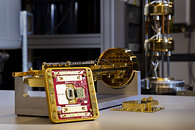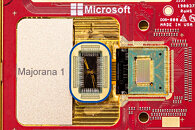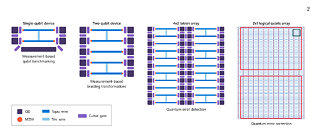- Joined
- Aug 19, 2017
- Messages
- 2,809 (1.02/day)
Microsoft has launched Majorana 1, the world's first quantum processor powered by a Topological Core architecture, marking a significant step toward fault-tolerant, utility-scale quantum computing. The chip leverages tetron qubits—topological qubits built on Majorana zero modes (MZMs)—to achieve stability and scalability, with a roadmap to one million qubits, a threshold critical for solving industrial challenges like microplastic degradation and self-healing materials. At the heart of Majorana 1 lies a superconductor-semiconductor heterostructure combining indium arsenide and aluminium. This "topoconductor" material enables precise control of MZMs, exotic quantum particles that encode information non-locally, inherently resisting noise and errors. The design, detailed in the latest paper, arranges MZMs in H-shaped nanowires, forming two-sided tetrons that suppress errors exponentially via three factors: topological gap-to-temperature ratio, wire length-to-coherence length, and high-fidelity microwave readout. Microsoft claims that thopoconductor can "create an entirely new state of matter - not a solid, liquid or gas but a topological state."
Unlike conventional qubits requiring analog tuning, Microsoft's architecture uses digital voltage pulses for error-resistant, measurement-based operations. This approach simplifies scaling, with the current chip housing eight tetrons and supporting protocols for quantum error detection, such as the Hastings-Haah Floquet codes and ladder codes outlined in Microsoft's technical roadmap. These codes rely on single- and two-qubit Pauli measurements, native to tetrons, to detect and correct errors without complex gate sequences. DARPA's US2QC program validated that Microsoft's topology-first strategy minimizes overhead, enabling a future million-qubit system compact enough to fit in Azure datacenters. The chip's quantum capacitance measurement system detects parity shifts in microseconds, achieving a signal-to-noise ratio critical for fault tolerance. Applications span designing catalysts to break down pollutants, optimizing enzymes for agriculture, and simulating novel materials. Microsoft aims to merge quantum, AI, and high-performance computing into Azure, accelerating discoveries once deemed decades away. Majorana 1 proves that topological qubits—once a high-risk bet—are now the cornerstone of scalable quantum systems.



View at TechPowerUp Main Site | Source
Unlike conventional qubits requiring analog tuning, Microsoft's architecture uses digital voltage pulses for error-resistant, measurement-based operations. This approach simplifies scaling, with the current chip housing eight tetrons and supporting protocols for quantum error detection, such as the Hastings-Haah Floquet codes and ladder codes outlined in Microsoft's technical roadmap. These codes rely on single- and two-qubit Pauli measurements, native to tetrons, to detect and correct errors without complex gate sequences. DARPA's US2QC program validated that Microsoft's topology-first strategy minimizes overhead, enabling a future million-qubit system compact enough to fit in Azure datacenters. The chip's quantum capacitance measurement system detects parity shifts in microseconds, achieving a signal-to-noise ratio critical for fault tolerance. Applications span designing catalysts to break down pollutants, optimizing enzymes for agriculture, and simulating novel materials. Microsoft aims to merge quantum, AI, and high-performance computing into Azure, accelerating discoveries once deemed decades away. Majorana 1 proves that topological qubits—once a high-risk bet—are now the cornerstone of scalable quantum systems.



View at TechPowerUp Main Site | Source




